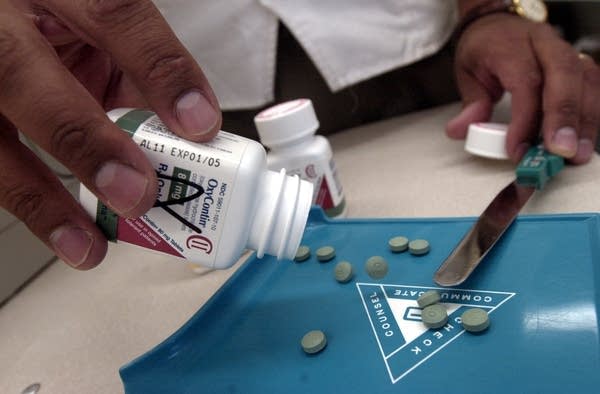Report: Twin Cities heroin use rising, opiate use may be slowing
Go Deeper.
Create an account or log in to save stories.
Like this?
Thanks for liking this story! We have added it to a list of your favorite stories.

A new report on drug trends in the Twin Cities shows heroin use remains a growing problem, while the abuse of opiate-based pain killers, like methadone and OxyContin, may be slowing.
During the first half of 2012, treatment centers saw a slight drop in the number of people admitted for opiate abuse. Doctors and drug abuse experts say that's an encouraging sign, but they say it's too early to know if it a trend that will continue.
More than 21 percent of people in Hennepin, Ramsey, Anoka, Dakota, Washington counties entering treatment programs early last year were battling an addiction with either heroin or opiate-based prescription pain killers.
Graph: Drug trends in Minnesota
Turn Up Your Support
MPR News helps you turn down the noise and build shared understanding. Turn up your support for this public resource and keep trusted journalism accessible to all.
"Heroin and other opiates are second only to the number of people coming into treatment for alcohol," said Carol Falkowski, the principal at Drug Abuse Dialogue, a drug abuse education company. "That is a relatively new phenomena in the Twin Cities and something that we should all be concerned about."
Falkowski authored the twice annual-report for the National Institute on Drug Abuse.
"While heroin continues to increase, perhaps prescription opiates are slowing down a bit," Falkowski said. "Those two lines that have been going up in tandem, separated when you look at the first six months of 2012 and it could be the beginning of a turning of the tide with prescription opiates."
Drug abuse experts and doctors say there are several reasons for why that might be the case.
Heroin is an opiate that provides a similar high to prescription drugs like OxyContin, and it's less expensive.

"I mean, are you going to spend $80 a day on OxyContin pills? Or you can get the same bang, or maybe more bang for your buck, spending $40 a day on heroin? It's economics," said Dr. Gavin Bart, who directs the division of addiction medicine at Hennepin County Medical Center and researches opiate dependency.
Bart said the report follows national drug abuse trends. But he said the Twin Cities has experienced some of the cheapest, purest heroin in the country.
"What is probably happening is there's a marketing battle between the dealers and the people who peddle prescription opiates and the heroin traffickers," Bart said. "In order to get a good customers you increase the quality and decrease the price, which is what's happened with heroin and it's just pulling market share from the prescription opiate addicts."
Users may also be turning away from opiate-based pain killers in favor of heroin, because the prescription drugs are more difficult to get.
The Minnesota Prescription Monitoring Program requires a pharmacy that fills a controlled substance to list that prescription to a central database within a week.
Bart said that helps reduce the amount of prescriptions doctors write.
"Any physician who's maybe about to write a prescription for an opiate can look up that patient to see perhaps are there five other physicians also writing that same prescription," Bart said.
Doctors aren't required to check the database, Bart said, but more health systems are incorporating it.
And while heroin is the larger problem in the Twin Cities, research shows prescription opiate abuse remains more prevalent in rural parts of the state.
Graphs by Robert Boos, Minnesota Public Radio
REPORT:
Dear reader,
Political debates with family or friends can get heated. But what if there was a way to handle them better?
You can learn how to have civil political conversations with our new e-book!
Download our free e-book, Talking Sense: Have Hard Political Conversations, Better, and learn how to talk without the tension.




